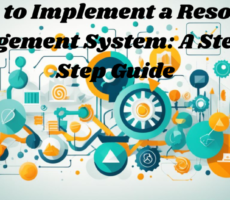How to Implement a Resource Management System: A Step-by-Step Guide
Effective resource management is vital for any organization to succeed. Therefore, with a robust system in place, companies can make the most of their assets. Consequently, they can improve workflow, increase productivity, and better use what they own. This guide will cover all the essential steps to implement a sound resource management system. In addition, you will learn about allocating resources wisely, planning capacities, and controlling inventory.
Learning resource allocation strategies is critical to a sound resource management system. Specifically, this means using data to distribute resources, like people and money, wisely. Consequently, it helps your projects and company goals match up. Furthermore, using project planning software lets teams handle jobs, timelines, and what they need together, thereby making projects run smoother.
It’s also essential to consider workforce optimization and capacity planning. It’s about cleverly fitting work hours, skills, and when people work together. This ensures everyone does well and work gets shared fairly.
In the last piece of the puzzle, inventory control techniques and asset tracking tools play a significant role. They help keep an eye on what’s in stock and physical assets. These steps, from buying smartly to using resources entirely, really add value to a company.
How to Implement a Resource Management System
Resource management is critical to project success. First, a plan must be made to put resources where they’re needed. This plan includes identifying what’s most important, like people, tools, and materials, to meet the company’s goals.
Read Also: Mastering Resource Management Software: A Guide to Effective Usage
Resource Allocation Strategies
Demand forecasting is crucial in resource management. It means predicting what resources will be needed and when. This could mean looking at past data, keeping an eye on what’s happening in the market, and talking to partners about what they might need.
Getting the right people for each job is also vital. Workforce optimization is about assessing who has the skills, is available, and is manageable to work on specific tasks. Matching the perfect team to each job boosts productivity and efficiency.
Project Planning Software
Many companies use project planning software for better resource management. Specifically, these tools help with assigning resources, creating schedules, and keeping track of progress. Consequently, they make managing resources easier. Moreover, they provide a clear view of projects, which in turn helps make intelligent choices about using resources.
A successful resource management system considers your company’s needs and challenges. It uses good strategies and the right tools, like project planning software, to ensure that resources support the company’s goals and are used well.
Workforce Optimization and Capacity Planning
Optimizing your workforce and planning capacity is vital to healthy resource management. With data-driven insights and advanced models, an organization ensures it matches business demands well.
Capacity planning methods are crucial for optimizing your workforce. They first look at past data, then consider current trends, and finally, analyze future needs. This comprehensive approach helps to pick just the correct number of people with the needed skills to handle upcoming work. Moreover, scheduling algorithms come in handy, as they make assigning tasks and using resources more efficient.
- Utilize real-time data monitoring and predictive analytics to forecast future resource needs.
- Implement flexible staffing models, such as part-time or on-demand workers, to adapt to fluctuating demands.
- Invest in workforce training and development to ensure employees have the necessary skills to support business objectives.
Read Also: Resource Management for Beginners: A Guide
With the proper capacity planning, you can enhance your productivity and cut costs. Your organization will also become more flexible, reacting better to marketplace changes. This approach also helps improve workforce optimization and resource management.

For success, it’s vital to analyze data and implement intelligent strategies sincerely. Remember to keep using new methods that fit your growing business needs.
Inventory Control and Asset Tracking Tools
Managing resources means more than just people. It includes handling physical assets and inventory well. Techniques like just-in-time (JIT) and economic order quantity (EOQ) can boost supply chain efficiency. This reduces waste and cuts down on excess costs. By watching over your inventory and ordering wisely, you will cut down on waste. This ensures your organization always has what it needs.
Inventory Control Techniques
Just-in-time (JIT) is a lean method. It aims to get goods only when needed in production. This cuts storage costs and reduces waste. On the other hand, economic order quantity (EOQ) finds the best order size. This minimizes the costs of holding and ordering. Both JIT and EOQ let you manage your inventory better. You keep a close eye on your organization’s physical resources.
Asset Tracking Tools
Asset tracking tools give great insight into your valuable equipment’s status and location. Tools like barcoding and RFID technology help you keep track. They watch how equipment is used, maintained, and where it is, ensuring your resources are used well and lowering the chance of losing or misplacing them.
Read: How to Plan and Finance Your Business: A Comprehensive Guide
Conclusion
A practical resource management system is critical for organizations wanting to boost productivity. Also, it helps cut down on costs while improving the use of their team and assets. Using the tips in this guide, you can implement a system that meets your business goals. This will help your organization grow steadily.
To get started:
- Look at what your group needs in terms of resources.
- Find areas that you can make better use of.
- Check how you’re using resources now.
With this information, you can create a system that makes things run smoother. This system will help you make better choices and work more efficiently.
As you implement the system, keep your eyes on several goals. Know how to implement a resource management system, resource allocation strategies, and workforce optimization. Including these aspects in your plan is crucial. It ensures your system brings real advantages and helps your group succeed long-term.
